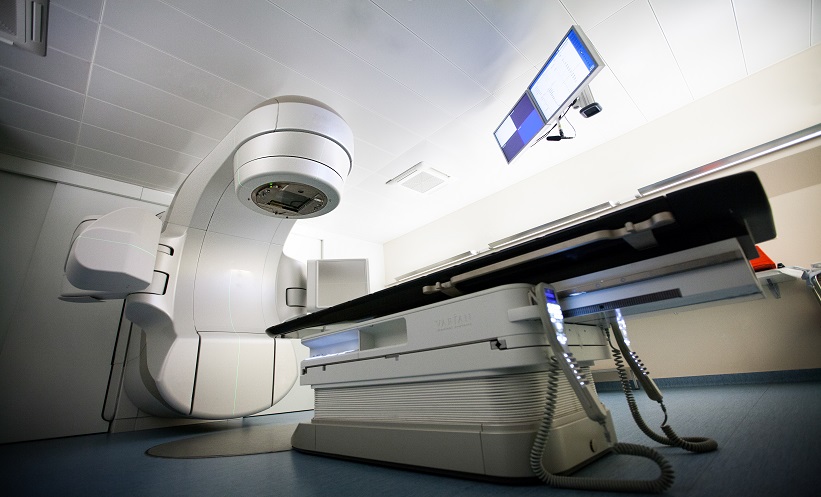Author: Helena Bradbury, EMJ, London, UK
Citation: EMJ Urol. 2024;12[1]:17-20. https://doi.org/10.33590/emjurol/YYYW6494.
![]()
IS PROSTATE MRI THE NEW GOLD STANDARD?
Marcelo Langer Wroclawski, Centro Universitário Faculdade de Medicina do ABC, Santo André, Brazil, opened his talk with an alarming statistic: over 50,000 new cases of prostate cancer are diagnosed every year. Whilst conventional screening reduces the relative risk of death from prostate cancer by approximately 20%, this carries a risk of overdiagnosis. This leads to overtreatment, with over 40% of patients treated with radiotherapy or chemotherapy, even if diagnosed with low-risk prostate cancer. In an effort to combat overdiagnosis and overtreatment, Wroclawski stressed the need for a diagnostic tool, with a high negative predictive value, so that biopsies are only performed for those who really need it.
According to Wroclawski, the solution is MRI. The Prostate Imaging-Reporting and Data System (PI-RADS) is a scoring tool used by radiologists to determine the likelihood of prostate cancer; a score of 1 means a low probability of prostate cancer, and a score of 5 means a high probability that you have prostate cancer that needs to be treated. The incidence of clinically significant prostate cancer for PIRADS 1, 2, 3, 4 (positive), and 5 (positive), was 2%, 4%, 20%, 52%, and 89%, respectively. As highlighted by Wroclawski, the integration of a pre-biopsy MRI stage allows us to move to a more tailored approach in identifying patients that should proceed with biopsies. This approach was shown to increase the detection of clinically significant prostate cancer cases by 18%, as well as decreasing the detection of clinically insignificant cases by 40%, and avoiding unnecessary biopsies, which carry their own set of complications, in 49% of cases.
UPDATE ON PROSTATE-SPECIFIC ANTIGEN PET/CT
Wolfgang Fendler, Department of Nuclear Medicine, University of Duisburg-Essen, and German Cancer Consortium-University Hospital Essen, Germany, subsequently provided an update on the use of prostate-specific membrane antigen (PSMA)-PET/CT imaging for prostate cancer detection. PSMA is a glutamate carboxypeptidase II that is highly expressed in primary and metastatic prostate cancer, and is thus targeted by radioligands for both diagnostic PET imaging and radiotherapy. Fendler referenced several studies assessing the detection capabilities of PSMA-PET in all stages of prostate cancer, from initial to advanced, with promising results in sensitivity, specificity, positive predictive value, and management impact, amongst others.
Despite encouraging evidence on PSMA-PET prostate cancer detection, more randomised clinical trials are needed to validate PSMA-PET, and establish its place in the clinical management of prostate cancer. Fendler touched on PRIMORDIUM, a randomised, international trial-in-progress that is utilising PSMA-PET to identify those at high-risk for prostate cancer recurrence following radical prostatectomy. This treatment cohort will then receive apalutamide, a next-generation nonsteroidal androgen receptor antagonist, in combination with radiotherapy and luteinizing hormone-relating agonist.
Looking to the future, Fendler identified four fields that he believes to be important in providing evidence on PSMA-PET and survival. These included PSMA-direct radioligand therapy, metastasis-directed treatment, salvage radiation therapy, and curative-intent radiation therapy.
TRANSPERINEAL PROSTATE BIOPSY: THE PROS AND CONS
The landscape of prostate biopsy methods was a subsequent subject of debate, spearheaded by Christian Gratzke, Department of Urology, Albert-Ludwigs-University, Freiburg, Germany; and R.R Tourinho-Barbosa, Department of Urology, Institut Mutualiste Montsouris, Université Paris-Descartes, France. Transperineal and transrectal biopsies are two techniques used to collect sample tissue from the prostate to diagnose cancer. In the former, the biopsy needle is inserted through the wall of the rectum to reach the prostate gland, whilst in the latter, the needle enters through the skin between the scrotum and anus.
Opening his defence of transperineal biopsy, Gratzke quoted a common argument: “Transrectal biopsies are so easy to perform. I hardly ever see any severe infections as a complication. So why is there a need for transperineal biopsies?” He discussed a study that compared the rate of infections between two patient groups: those receiving transperineal biopsy without antibiotic prophylaxis, and those receiving transrectal biopsy with targeted prophylaxis. Of the total 658 participants, zero transperineal infections were reported, compared to four (1.4%) transrectal biopsy infections (p=0.059). Importantly, the detection of clinically significant cancer, that requires immediate treatment, was similar (53% transperineal versus 50% transrectal).1
These discoveries not only affirm the effectiveness of transperineal biopsy, but also alleviate the demand for healthcare resources, as emphasised by Gratzke. For instance, providing targeted prophylaxis with biopsy requires a rectal culture from the patient; a nurse practitioner and/or physician to select and prescribe antibiotics based on the antibiogram results and patient allergies; and finally, the patient must adhere to the planned antibiotic regime, and the physician must verify treatment compliance. These demands deplete resources and time, and even with the use of prophylaxis there is still an albeit small risk of infection following transrectal biopsy.
Presenting the counterargument, Tourinho-Barbosa stressed the negative associations of transperineal biopsy, namely the increased risk of acute urinary retention, higher cost, and lower tolerability. Furthermore, he referred to several recent studies illustrating lower infection rates for transrectal biopsies, contrasting with earlier literature. Additionally, findings from studies such as the Prostate Biopsy Effects on Prostate Cancer Detection (ProBE-PC) study indicate comparable detection rates between both biopsy techniques.
Tourinho-Barbosa concluded his argument with an insightful question: “Should we focus solely on the route, or instead on improving the detection rate of clinically significant disease?” In answer to this, he drew on new technologies, such as Micro-US, which is capable of revealing lesions not seen on MRI, and suitable for both biopsy approaches.
INDICATIONS, ADVANTAGES, AND DISADVANTAGES OF FOCAL TREATMENT MODALITIES
Focal therapy refers to the removal of the cancer, whilst leaving the rest of the organ intact, with the aim to retain as much function as possible, and minimise any adverse effects. Rafael Sanchez-Salas, Department of Surgery, Division of Urology, McGill University, Montréal, Québec, Canada, drew on the benefits and current challenges facing focal therapies.
The Focal Lesion Ablative Microboost in Prostate Cancer (FLAME) trial investigated whether focal boosting of the macroscopic visible tumour with external beam radiotherapy increases biochemical disease-free survival in patients with localised prostate cancer. This Phase III, multicentre, randomised controlled trial comprised 571 patients with intermediate- and high-risk prostate cancer, enrolled between 2009‒2015. Patients received either the standard treatment of 77 Gy to the entire prostate, or a focal boost up to 95 Gy to the intraprostatic lesions. Findings demonstrated that at the 5-year follow-up, the biochemical disease-free survival was significantly higher in the focal boost compared to standard radiotherapy: 92% to 85%, respectively. These findings suggest promising prospects for the future of prostate cancer treatment, indicating that implementing the focal boost technique could potentially enhance long-term outcomes for patients undergoing radiotherapy.
In his concluding remarks, Sanchez-Salas emphasised that focal therapy remains a dedicated risk assessment process, and that definitive data about long-term cancer control are still lacking.
RELIABILITY OF IMAGING MODALITIES FOR FOCAL TREATMENT
Jochen Walz, Institut Paoli-Calmettes Cancer Center, Marseille, France, discussed the reliability of imaging modalities for focal treatment of prostate cancer. Drawing on two separate studies, Walz emphasised how two factors, the reader’s expertise and biopsy operator, can significantly impact the detection rate of clinically significant prostate cancer. For instance, the percentage of missed T3 prostate cancers dropped from 22% to 3% when read by experts compared to general multiparametric MRI, whilst detection rate fluctuated from 27‒53% solely based on the operator’s skill in targeted biopsy.
Systematic biopsy is where samples of tissue are removed from different areas of the prostate to examine under a microscope, whereas targeted biopsy uses advanced imaging techniques to identify areas of the prostate suspicious for cancer, and then directly biopsies them. Generally, the detection and classification of prostate cancer, based on the Gleason score, is superior in targeted biopsies. Yet, as highlighted by Walz, even with targeted biopsy, there remains a potential 30% chance of classification change for radical prostatectomy specimens, casting doubt on the reliability of grading from targeted biopsies.
Further explaining his argument, Walz referenced a 2017 study, which demonstrated that MRI underestimates cancer volume, especially for lesions with a high imaging suspicion score and high Gleason score. In his closing remarks, he stressed the importance of patient selection for focal therapy. Template-guided biopsy provides the best evaluation; however, it is not yet applicable in routine. MRI is the best alternative but, as emphasised by Walz, the “quality chain” of the MRI-based pathway is very important. This includes MRI acquisition, MRI reporting, lesion targeting, and pathology reporting.
CONCLUSION
The joint EAU and CAU session brought to light key advancements and debates in urological care. From the adoption of MRI as the primary diagnostic tool for prostate cancer to discussions on the efficacy of transperineal biopsies, and the potential of focal therapies, the congress highlighted a shift towards personalised, targeted approaches.







